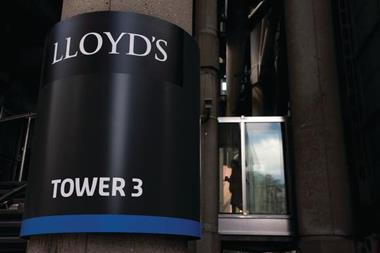Will the market heed Lloyd’s chief Richard Ward’s warning over technological uptake? Emma Jones reports
If you turn back the clock 18 months at Lloyd’s, what do you see? You see a market scooping up the remains of another costly technology drive and a market grappling with business process reform.
Fast forward to the present day and the market has a very different complexion. The lessons of Kinnect have been learned and rising from the flames are small, bite-sized solutions aimed at streamlining market processes.
Processes, such as Electronic Claims Files (ECF) and the Accounting and Settlement repository (A&S), are working and in use. The market, according to chief executive Richard Ward is showing a “shared will” to improve processes. But the market has a way to go.
In a stiff letter to the market this week Ward threatened to force underwriters to use electronic processes. “Failure to improve our processes represents a significant risk to the market’s efficiency, ratings and reputation and we cannot miss this opportunity to modernise,” he wrote.
He warned that failure to improve would represent a “significant risk” to the market’s efficiency.
There can be little doubt the opportunity to modernise has been recognised by the market.
According to James Willison, managing director of Web Connectivity, an ACORD gateway provider, in the last 12 months he has seen a “massive” increase in both the take-up and interest in messaging gateways.
“In many cases the technology is available,” adds Willison. “It is now a case of ensuring that the necessary cultural changes do happen.”
The clock, however, is now rapidly ticking for all managing agents and brokers to commit to such changes.
Attainable targets
The latest figures, showing current usage of ECF and A&S, only go to demonstrate the difficulty Lloyd’s has in convincing every market practitioner to use the systems.
The market’s current use of A&S is 17%, a long way off the Market Reform Group’s (MRG) target for A&S take-up of 40% by the end of June.
It now has to pick up the pace if it’s to meet the 60% target set for the end of quarter three and 80% by end of quarter four 2007.
ECF figures make for slightly better reading: the market level use of ECF over the last two weeks is 28.5%. Again the published MRG targets for ECF usage are equally as ambitious, 30% by the end of June, 60% by end of quarter three and 100% by end of quarter four 2007.
To quote Ward, the rate of adoption is “disappointing”, but, will the market be able to prove him wrong, speed things up and hit those targets?
David Gittings, chief executive of the Lloyd’s Market Association (LMA), displays unshakeable optimism in his members’ ability to rise to the challenge.
“London needs to complete its reform agenda, unlock the value and get back to doing what it's best at - delivering world class customer solutions and service from the most efficient global platform
Lynton Hussey, Aon
“The targets are achievable,” he insists. “We are very close to meeting the ECF targets of 30% and I am confident that by the autumn we will reach the next target of 60%. Evidence so far is that it will be done.”
Gittings adds: “In regards to A&S it is disappointing that the number was only 17%, but one thing that Richard Ward recognises is that the use of A&S is driven by what the broker does. The fact that the London Market Insurance Brokers’ Committee (LMBC) is part of the market reform group and party to agreeing the targets means they too are in agreement that the targets are achievable.”
It seems too that the larger brokers share the same optimism that all new claims must be processed electronically by the end of the year. “We are very keen to see this happen – Lloyd’s needs to keep the pressure on both insurers and brokers to reach this worthwhile goal,” Lynton Hussey, reinsurance claims managing director, Aon. “I think the combination of the LMA and Lloyd’s together with a consistent message will help enforce the appropriate goals – but client service must be the target not arbitrary 100% goals.”
The difficulty in meeting the MRG’s demands within such a tight framework is that it will require the London subscription market as a whole to fully embrace reform and in relation to electronic claims files, for all classes of business and legacy claims.
Hussey insists change management is key. “Organisations have different priorities and business models – we have to work at the pace of the fastest if we are to succeed.
“London needs to complete its reform agenda, unlock the value and get back to doing what its best at – delivering world class customer solutions and service from the most efficient global platform.”
The call for action is clear to hear, but with such high expectations is there a certain in-evitability that the Franchise Board will be called upon to take “firm action” to accelerate change?
Gittings thinks not. “My view is it won’t be necessary to mandate, because a) the market will reach the targets, specifically ECF, and b) the mere fact of sending a letter to the market will help to concentrate people’s minds that they will reach those targets.”
In his market letter, Ward reiterated threats made in May that he will publish a complete list of performance figures for all managing agents and for Lloyd’s brokers, and consider mandating the use of ECF and A&S under paragraph 12 of the underwriting byelaw.
Lloyd’s may even go as far to make managing agents enter into revised terms of business agreements with Lloyd’s brokers to agree contractually the appropriate use of ECF and A&S; restrict business plans where poor performance is directly linked to the competence or the capabilities of the managing agent; and, where a managing agent’s performance is unacceptably poor, impose a capital loading to reflect the threat this represents to the market as a whole.
The corporation appears to be taking the task of driving business process reform very seriously. A tactic welcomed by most.
“We applaud this move wholeheartedly,” insists Charles Dupplin, director of M&A, Hiscox. “The key element is the threat of imposition of capital loadings on businesses that do not move to achieve these realistic targets.
“The naming and shaming of those that let the London market down is also a strong and in some quarters unpopular move. London is now looking like it is waking up to the job of turning itself back into the best market to place internationally traded business.”
As Gittings rightly points out, “the hard work has been done, the ball has been pushed up the hill, tipped over and is rolling down the other side – there is no stopping the momentum.”
So, turn the clock forward 18 months and what will you see at Lloyd’s? The general consensus seems to be: reform.
Hosted by comedian and actor Tom Allen, 34 Gold, 23 Silver and 22 Bronze awards were handed out across an amazing 34 categories recognising brilliance and innovation right across the breadth of UK general insurance.








































